DNA, the blueprint of life, comprises various complex molecules, each playing a critical role in genetic functions. Among these molecules, thymine and thymidine stand out due to their unique functions and structures within DNA synthesis and repair. Their significance extends beyond mere components of DNA, influencing genetic stability and cellular processes.
Thymine and thymidine, though similar sounding, differ fundamentally. Thymine is one of the four nucleobases in the DNA molecule, pairing with adenine to form the DNA structure. Thymidine, on the other hand, is a nucleoside comprising thymine attached to a sugar molecule, deoxyribose, playing a crucial role in DNA replication.
This distinction is pivotal for various biological processes, where thymine functions primarily within the DNA strand, and thymidine participates actively in the DNA replication process. Understanding these differences enhances our grasp of genetic mechanisms and their implications in health and disease.
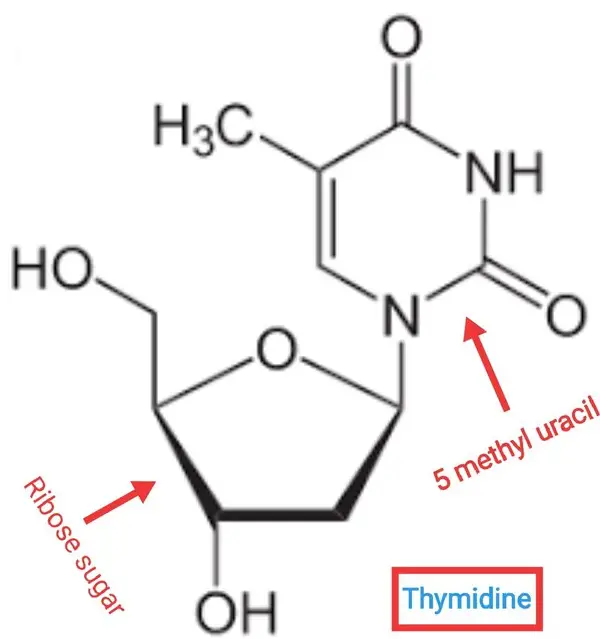
Thymine Basics
Definition and Role in DNA
Thymine is one of the four nucleobases in the nucleic acid of DNA, represented by the letter T in the DNA sequence. It pairs with adenine (A) through hydrogen bonds to form the A-T base pair, crucial for DNA structure. This base pairing is fundamental in the double helix configuration of DNA, helping to stabilize the nucleic acid structure which carries genetic information in organisms.
Chemical Structure
The chemical structure of thymine is characterized by a single-ring molecule known as a pyrimidine. Its structure includes two oxygen atoms, three nitrogen bases, and a carbon ring, making it non-polar and hydrophobic, which influences its placement within the DNA strand, typically opposite adenine, which also has a complementary shape and properties.
Biological Function
Thymine plays a pivotal role in the biological function of DNA, which involves:
- Genetic encoding: Thymine codes genetic information for the synthesis of proteins.
- DNA replication: During DNA replication, thymine pairs with adenine to ensure accurate genetic copying.
- Repair and mutation prevention: Helps maintain DNA integrity by participating in DNA repair mechanisms which prevent mutations.
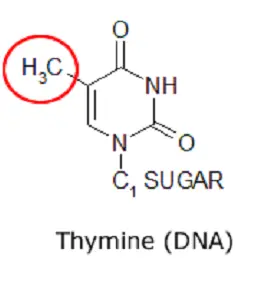
Thymidine Essentials
Definition and Context
Thymidine is a nucleoside comprising thymine attached to a deoxyribose sugar molecule. It differs from thymine in that it is not just a base but a building block of DNA that includes both a base and a sugar component. Thymidine is a fundamental component in the nucleoside form, which is involved in the construction of the DNA strand during the phase of DNA replication.
Chemical Composition
The structure of thymidine includes:
- Thymine base: The pyrimidine nucleobase.
- Deoxyribose sugar: A five-carbon sugar molecule that connects to the thymine base through a glycosidic bond.
This composition makes thymidine crucial for DNA replication, as it is readily incorporated into the growing DNA strand.
Role in DNA Replication
In DNA replication, thymidine is incorporated into the DNA molecule by enzymes called DNA polymerases. These enzymes aid in forming the phosphodiester bonds that link the nucleosides, creating a new strand of DNA. The presence of thymidine in the replication process ensures that the genetic information is transferred accurately from one cell to another during cell division.
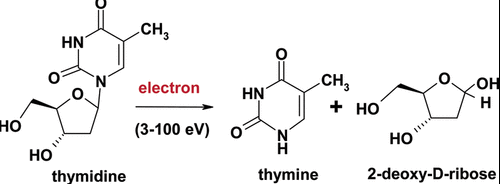
Key Differences
Molecular Structure Comparison
Thymine and thymidine differ significantly in their molecular structure:
- Thymine: Just a base (pyrimidine).
- Thymidine: A nucleoside consisting of thymine and a sugar molecule.
This difference in structure affects how each of them interacts within the DNA molecule.
Functional Distinctions
While thymine’s function is restricted to pairing with adenine within the DNA strand, thymidine has a broader role, including:
- Participation in DNA synthesis: Acts as a monomer in the synthesis of new DNA strands.
- Regulation of DNA replication speed: Influences the rate of DNA chain elongation.
Involvement in Biological Processes
The roles of thymine and thymidine extend to different biological processes:
- Thymine: Primarily involved in transcription and mutation prevention.
- Thymidine: Besides DNA replication, it is also significant in DNA repair and cellular metabolism.
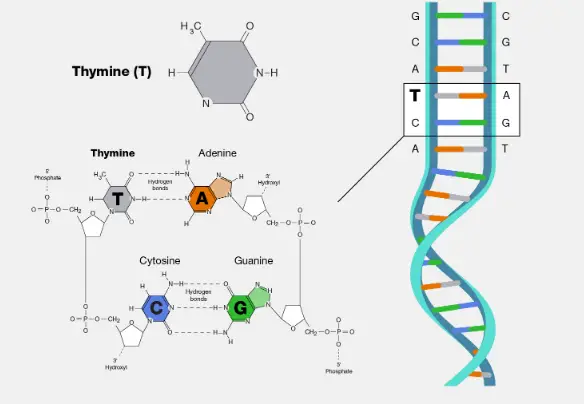
Biological Implications
Thymine in Mutations
Thymine is critical in DNA stability, yet its role in mutations is equally significant. When mutations involve thymine, they often lead to base pair mismatches or disruptions in the DNA sequence. This can result from several mechanisms:
- Thymine dimers: Form when two adjacent thymine bases bond covalently after exposure to ultraviolet light, leading to DNA replication errors.
- Deamination: Occurs when thymine is mistakenly replaced by uracil (a base normally found in RNA), a process that can lead to base-pair substitutions during DNA replication.
These mutations can contribute to diseases such as cancer, where genetic integrity is compromised, and hereditary conditions where these errors are passed down through generations.
Thymidine in Cellular Functions
Thymidine plays versatile roles in cellular functions beyond DNA replication. It is crucial in:
- DNA repair: Thymidine is involved in the repair processes that correct DNA damage and ensure cellular health.
- Regulation of the cell cycle: Thymidine levels are monitored within cells to control the progression of the cell cycle, affecting cell division and growth.
The availability of thymidine can influence the rate at which cells divide, making it a key factor in both normal and cancerous cell growth.
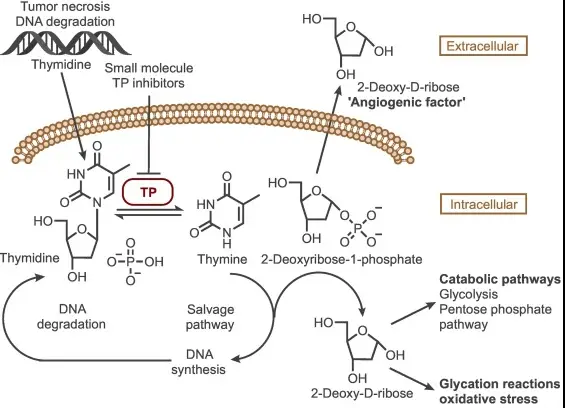
Thymine vs Thymidine in Research
Usage in Scientific Studies
Thymine and thymidine are used extensively in molecular biology and genetics research. Their applications include:
- Labeling of DNA: Thymidine can be labeled with radioactive isotopes to trace new DNA synthesis in cells, a method widely used in cancer research and developmental biology.
- Molecular markers: Thymine derivatives are often used as markers in genetic assays and for identifying specific sequences within a large DNA molecule.
Impacts on Genetic Engineering
Both thymine and thymidine have profound impacts on genetic engineering:
- Gene editing: Techniques such as CRISPR utilize thymine-specific guides to target and modify specific DNA sequences.
- Synthetic biology: Researchers use thymidine and its analogs to create synthetic DNA with novel properties for various applications, from new therapies to bioengineering.
These tools and methodologies are revolutionizing how scientists manipulate genetic material, offering new ways to tackle diseases and understand life processes.
Practical Applications
Thymidine in Medical Treatments
Thymidine’s role extends into medical applications, particularly:
- Antiviral and chemotherapy agents: Thymidine analogs are used in the treatment of viral infections and cancer because they can inhibit DNA synthesis in pathogens or tumor cells.
- Diagnostic imaging: Radioactively labeled thymidine is used in imaging tests to assess tissue growth or tumor activity in the body.
These applications highlight thymidine’s importance in both therapeutic interventions and diagnostic procedures.
Thymine in Biotechnology
In biotechnology, thymine has several applications:
- Genetic testing: Thymine-based probes are critical for detecting specific DNA sequences in genetic testing processes.
- Biotechnology research: Thymine’s unique properties make it ideal for developing new biotechnological tools, such as novel enzymes or enhanced genetic vectors.
The versatility of thymine in biotechnology not only advances research but also aids in the development of new technologies for improving health and understanding biological complexities.
Frequently Asked Questions
What is Thymine?
Thymine, a pyrimidine nucleobase, is essential in DNA, pairing with adenine through two hydrogen bonds to stabilize the nucleic acid structures. It is critical for accurate DNA replication and repair, ensuring genetic fidelity.
What is Thymidine?
Thymidine is a nucleoside involving thymine and deoxyribose, a sugar. It serves as a building block in DNA replication and is vital for proper cell division and DNA repair processes, especially in rapidly dividing cells.
How do Thymine and Thymidine differ?
While thymine is a base alone, thymidine is a nucleoside that includes both thymine and a sugar molecule (deoxyribose). This structural difference is crucial as it changes how each component interacts within cellular processes and DNA synthesis.
Why is Thymidine important in medicine?
Thymidine is pivotal in medical research and treatments, particularly in cancer therapy, where it is used to monitor tumor growth and as a component in radiolabeled diagnostic tests. Its ability to incorporate into DNA makes it invaluable in studying cell proliferation.
Can Thymine mutation affect health?
Mutations involving thymine can lead to serious health issues, including cancer and genetic disorders. Thymine mutations often result in incorrect DNA pairing, which can disrupt genetic instructions and lead to malfunctioning proteins.
Conclusion
The roles and distinctions between thymine and thymidine are more than just academic distinctions; they are fundamental to the processes of life at a molecular level. Thymine forms the very structure of DNA, while thymidine facilitates the dynamic process of DNA replication and repair, influencing everything from cellular health to disease progression.
Understanding these molecules in depth provides insights into their critical roles in both normal cellular functions and pathological conditions. This knowledge not only enhances our understanding of genetic processes but also aids in the development of targeted therapies and diagnostics in medicine.

